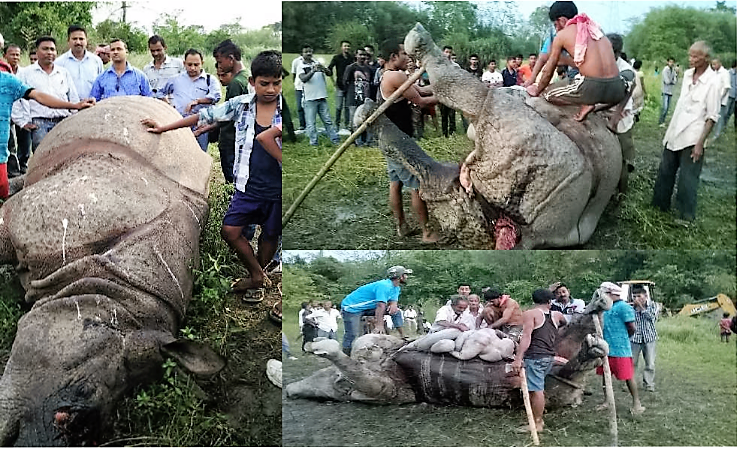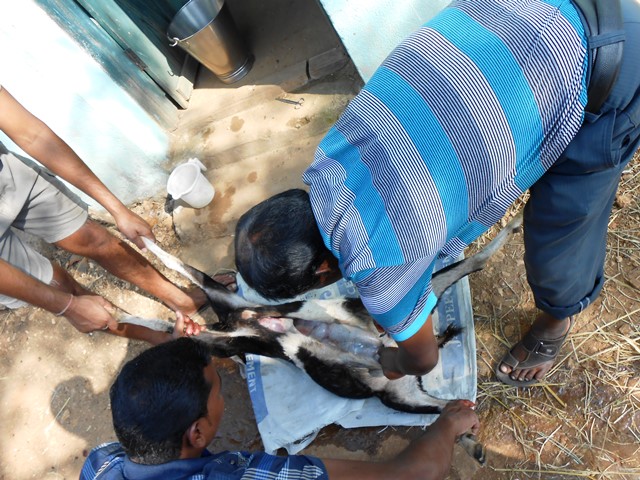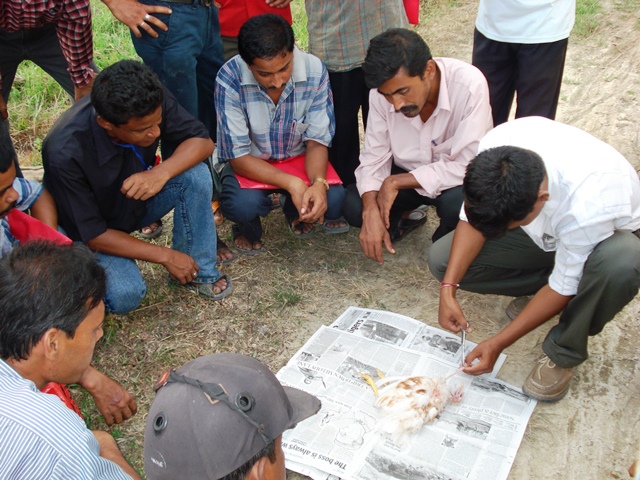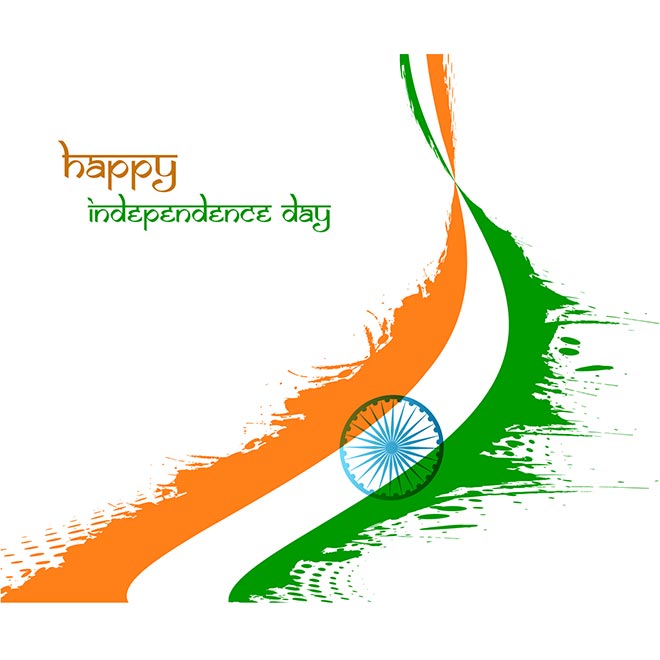There is a saying that “Postmortem examination is an art of disease diagnosis and the information we get is the message from the dead to the living”. Examination of the dead body by systemic dissection, recording of gross pathological lesions, and their correlation with history to make diagnosis of disease is called postmortem examination. The synonym used for postmortem examinations is necropsy in animals. It is not always possible to make conclusive diagnosis based on postmortem examination. For conclusive diagnosis materials are to be collected for further laboratory analysis. Postmortem examination which is performed to determine the probable cause(s) of death (along with additional laboratory test for confirmatory diagnosis) can aide in selecting the appropriate treatment for other animals within the herd / flock. Postmortem is an integral part of disease investigation. Postmortem examination assumes significant importance in the context of veterolegal cases and claim settlement for insured animals. Postmortem also helps to advance scientific knowledge in various areas of research and development. The objective of this article is to highlight the importance of postmortem examination, challenges faced by field veterinarians in India and to guide veterinarian on precautions to be taken along with link to available resources on postmortem techniques, steps in postmortem examination, determination of time of death, postmortem lesions of important diseases etc.
Indications of postmortem:
A postmortem examination should be carried out whenever possible most preferably in sufficient day light and it should be done thoroughly. Postmortem examination should be followed by microbiology, parasitological, histopathological, toxicological and clinical pathology if needed for further zeroing the cause of death. It should be performed on following conditions:
- Whenever there is an outbreak of disease
- For any vetero-legal cases such as accidents, poisoning etc.
- For insured animals to issue death certificates
- Validating the Scientific research
- To know the cause of death
- In any suspected cases of nature’s discourse. i.e. lightening, drowning, electric shock etc.
Points to remember while doing the postmortem:
Most of the veterinarians working in the field are forced to do a postmortem examination in a hurry or with some sort of local compulsion. One should remember the following conditions:
- Confirmation of death prior to postmortem is must.
- PM should not be conducted in carcass suspected to have died from anthrax (After suspecting the presence of anthrax bacilli in blood smear from ear vein or oozing out of unclotted blood)
- PM should be conducted under sufficient day light.
- Written consent of owner for doing the postmortem is a must. Requisition letter from competent authority (e.g. Police officer not below rank of inspector or magistrate) is particularly needed for vetrolegal and insurance related cases.
- Recording details of animal identification (e.g. Ear tag, breed, sex, age, length, height, girth behind fore limb, distance between horn tips) and maximum possible history (including date and time of death) prior to postmortem is of prime importance.
- Postmortem should not be done on carcass that are completely putrefied with liquefaction of all organs.
- Postmortem should be done only when carcass is presented as whole body (In case of drowned animals carcass is to be taken out of water and presented for postmortem)
- The carcass should be presented in its actual site as mentioned in the letter from owner/Police.
- In case of any scheduled or endangered animal species, due consent, information/permission should be taken from local forest officials and/or police before proceeding for postmortem examination.
- Postmortem area should be clean and the chances of environmental contamination should be minimal.
- All natural orifices should be closed with towel or cotton wool soaked in a disinfectant solution before removing carcass to place of postmortem examination.
- Handlers should protect themselves with gloves, apron, mask, cap, gumboot etc. to reduce the contaminations and infections. Movement of people to postmortem site should be restricted.
- It is the duty of the veterinarians to ensure proper disposal of the carcass after postmortem either through deep burial, incineration or rendering.
Owner’s responsibility:
Veterinarians should communicate following as owners responsibility:
- It is better for owner to take the early decision to allow post-mortem examination of his/her animals before the animal dies. It is important that he /she communicate wishes to the veterinarian early so that the necessary procedures can be scheduled rapidly, samples obtained quickly and the examination performed efficiently. Early postmortem optimizes the chances of getting useful results.
- Owner should be made aware of the importance of post mortem. If an animal dies at home and a veterinarian is not available, he / she should be asked not to freeze the body. It is much better to refrigerate only. This prevents freezing artifacts which confuse the pathologist examining the tissues.
- Owner should be educated on proper disposal of carcass after postmortem.
Constraints in field-practice:
Veterinarians working in the field have to do a multifarious work. This includes preventive disease investigation, vaccination, treatment, surgery as well as implementation of extension activities. He/she has to work in limited facility with respect to man power, easily accessible quality laboratory facility, supply of postmortem kits and personal protective gears etc. As the disease investigative procedure is not so modern, the field veterinarians are always in a dilemma about the possible confirmatory diagnosis. They have to take the risk of possible exposure of any zoonotic disease.
A good postmortem examination is a costly procedure. It takes time for veterinarian and his / her assistants to do a thorough examination. Laboratory costs are additional and same is often necessary for confirmatory diagnosis. Veterinarian who does the postmortem also has to travel to the door step of the owner. A rough estimate of expenses can be few hundreds rupees which generally the owners do not intend to pay after death of his/her animals.
While on field duty, I have received an urgent request from local forest officials to conduct PM on a rhino. There was no time to prepare or refer available protocol. I was asked to do postmortem on the dead rhino lying in a forest area at the bank of the river Brahmaputra. Because of its size and weight it is not practical to transport the dead animal to suitable location. There are more than 500 anxious villagers who are surrounding the dead animal. It was difficult to convince people and ensure restriction of movement. Though I was informed earlier that all necessary instrument and accessories will be provided on the site, personal protective materials were not available for forest guards who are asked to assist during the examination.
Dr. Sanjeeb Dutta, Veterinary Officer, Sootea State Veterinary Dispensary,
Sonitpur District, Assam, India
Though there are constraints, two most critical aspects where field veterinarian should give utmost importance are:
Use of personal protective clothing:
Many a times, postmortem examinations in field are being conducted by ignoring the protective clothing, thereby increasing the chances of contamination and infection to the surroundings as well as other livestock and human beings.
Scientific disposal of carcass after postmortem:
As per Government of India guidelines, it is the responsibility of the veterinarian to ensure the proper disposal of carcass after postmortem examination either by burial or incineration method. It is worthy to remember that the pit/burial site should be 250 meter away from any drinking water source and size of the pit should be bigger than the size of the animal, allowing all parts of the carcass to be buried completely in the pit. A layer of 5 cm lime shall be put at the bottom of the burial pit and again over the carcass before filling the soil. Disposal by incineration should be continued till the animal carcass is reduced to ashes.
Way forward:
Regular continuous education on postmortem should be made mandatory for the field veterinarians. This should cover postmortem changes and ways to determine time of death, lesions of important diseases, postmortem procedure and handling techniques, collection of samples for laboratory, rules and regulations, report writing format etc. A good art on postmortem surely has a better impact on updating one’s ability on disease investigation, surgery and treatment.
Postmortem related downloadable Indian resources for field veterinarians:
- Prevention and control of infectious and contagious diseases in Animals (Form of vaccination certificate, manner of postmortem examination and disposal of carcass) rules,2010, Gazette of India notification dated 14th December’2010.
- Course material of Veterinary Council of India’s CVE program on postmortem examination. (Courtesy: Indian Veterinary Association, Kerala) : PM_CVE_VCI
- Necropsy technique and necropsy conference manual. Edited by R Somvanshi & J R Rao, Indian Veterinary Research Institute (2009)
- Techniques and procedure for postmortem of Elephants. Published by Project Elephant and Central Zoo Authority, India. : Postmortem_Elephants
- Necropsy report format (Livestock / Poultry), DIL, Department of Animal Husbandry, Himachal Pradesh, India. : NecropsyReportformat_Himachal Pradesh
- Format for record of postmortem examination by National Tiger Conservation Authority, India. : PMReportformat_Tiger








